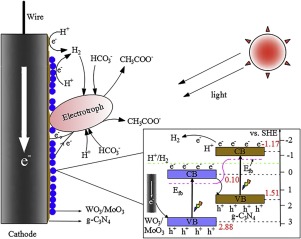Applied Catalysis B: Environment and Energy ( IF 20.2 ) Pub Date : 2020-01-11 , DOI: 10.1016/j.apcatb.2020.118611 Zhenghong Cai , Liping Huang , Xie Quan , Zongbin Zhao , Yong Shi , Gianluca Li Puma

|
The efficient production of acetate from HCO3- is demonstrated in a photo-assisted microbial electrosynthesis system (MES) incorporating a WO3/MoO3/g-C3N4 heterojunction photo-assisted biocathode supporting Serratia marcescens Q1 electrotroph. The WO3/MoO3/g-C3N4 structured electrode consisting of a layer of g-C3N4 coated on graphite felt decorated with W/Mo oxides nanoparticles exhibited stable photocurrents, 4.8 times higher than the g-C3N4 electrode and acetate production of 3.12 ± 0.20 mM/d with a CEacetate of 73 ± 4% and current of 2.5 ± 0.3 A/m2. Photo-induced electrons on the conduction bands of WO3/MoO3/g-C3N4 favoured hydrogen evolution, which was metabolized by S. marcescens with HCO3- to acetate, while the holes were refilled by the electrons travelling from the anode. Such mechanism reduced the interfacial resistances creating a supplementary driving force leading to higher acetate production. The biocompatible components of WO3/MoO3/g-C3N4 synergistically couple light-harvesting and further catalyze S. marcescens to acetate from HCO3-, providing a feasible strategy for achieving sustainable high rates of acetate production.
中文翻译:

从无机碳酯生产(HCO 3 - )使用光辅助生物阴极微生物电合成系统WO 3 /的MoO 3 / GC 3个Ñ 4个异质结和粘质沙雷氏菌物种
在结合了WO 3 / MoO 3 / gC 3 N 4异质结光辅助生物阴极,支持粘质沙雷氏菌Q1的电子辅助的光辅助微生物电合成系统(MES)中,证明了从HCO 3-高效生产乙酸盐的能力。WO 3 / MoO 3 / gC 3 N 4结构的电极,由涂覆有W / Mo氧化物纳米粒子装饰的石墨毡上的gC 3 N 4层组成,显示出稳定的光电流,比gC 3 N 4高4.8倍电极和醋酸盐产量为3.12±0.20 mM / d,CE醋酸盐为73±4%,电流为2.5±0.3 A / m 2。WO 3 / MoO 3 / gC 3 N 4的导带上的光生电子促进了氢的逸出,氢被S. marcescens与HCO 3-代谢为乙酸,而空穴被从阳极传播的电子重新充满。这种机制降低了界面阻力,从而产生了补充的驱动力,从而导致更高的乙酸酯产量。WO 3 / MoO 3 / gC 3 N 4的生物相容性成分协同作用使采光协同作用,并进一步将粘菌链霉菌从HCO 3催化成乙酸盐,为实现可持续的高乙酸盐生产速度提供了可行的策略。











































 京公网安备 11010802027423号
京公网安备 11010802027423号